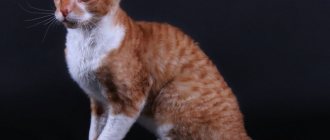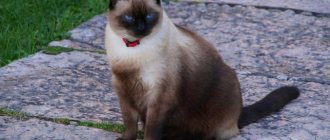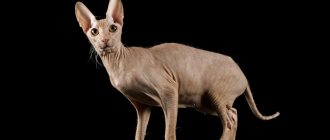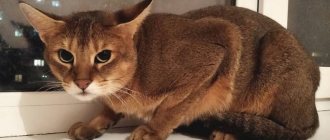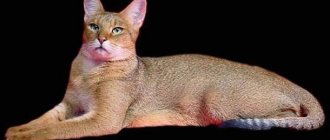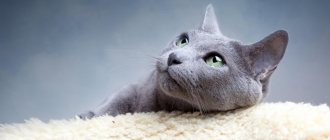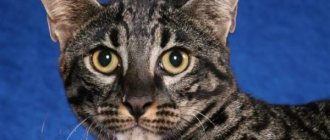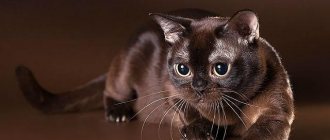Black-footed cat: description
African wild cats are not cute furry cats from cartoons. They are capable of terrifying even people, let alone small animals. One of the wild inhabitants of Africa is the African black-footed cat. A cute, cute animal lives in deserts and looks like a pet, although, unlike the latter, it has a far from peaceful disposition and tries very hard not to catch the eye of a person. Yes, the creature's appearance is very deceptive. The African black-footed cat is not a harmless creature, but a very dangerous and brave predator. The Aborigines are afraid of the beast and have long made up legends about it. It is worth noting that the cat is the smallest representative of wild cats. It is also called the ant tiger. This nickname speaks for itself.
The rarest breeds of spotted cats
Among the variety of cats with leopard coats, there are those that have not yet become widespread.
These include:
- Australian mist. The breed appeared as a result of crossing Burmese, Siamese and Abyssinians. It has many color options. But spotted cats look the most impressive.
- California radiant. Among the ancestors of these spotted cats are Angoras, Siamese, Manx, British Shorthair and Abyssinians. California shiners have a “wild” appearance. And on their luxurious fur coat there is a tabby pattern.
- Ussuri cat. In all likelihood, this young breed comes from Siberian and Amur cats. The spotted Ussuri visually resembles a predator and has a proud, independent disposition.
- Sokoke or Kenyan forest. This breed originated from kazonzo and partially feral domestic cats. It was approved in 1992 thanks to the efforts of Jenny Slater. Small, flexible, slender, spotted cats are endowed with a wayward, independent character and have a developed hunting instinct.
Spotted cat - Australian mist
Spotted cat - Californian shining
Spotted cat - Sokoke
Spotted cats attract attention with their natural grace and unusual appearance. Despite their “wild” appearance, many of them have a playful, affectionate disposition and high intelligence.
It is these qualities that make mini-leopards very popular among those who dream of getting closer to nature.
I like it I don't like it
Range of miniature predators
African wild cats live in the desert regions of South Africa. The animals have chosen a number of countries: Botswana, Angola, Namibia, Zimbabwe and South Africa. Scientists distinguish two varieties of black-footed cats. The more numerous of them are light in color and live in Namibia. The second group is much smaller in number and its representatives live in Botswana.
In a number of countries, rare wild cats are protected and hunting them is prohibited. Thus, Botswana and South Africa are concerned about preserving the population. In these countries, work is underway to combat poachers. In addition, animals often die from dog attacks and under the wheels of cars. Human activity also has a negative impact on the population size.
Kea
The inquisitive bird of the parrot family is affectionately called the “clown of the mountains.” It got its interesting name due to the specific sound it makes. Since 1970, the bird has been under enhanced protection as an endangered species. Their innate curiosity led to extinction at the hands of man. Kea is a very playful and friendly bird, easily gets used to people, learns the simplest commands, and adapts well to life in an apartment.
To visit the alpine parrot in its natural habitat, you will have to visit New Zealand. There they inhabit forest valleys. In conditions of limited will, Keas can live up to 50 years. They can be found in large zoos in Warsaw, Budapest, Vienna and Copenhagen. An obedient bird will probably even allow you to take a selfie with it.
A love of exploration and deft use of its beak leads to interesting antics of this feathered creature - the bird loves to climb into visitors' backpacks and hairstyles. Zoo staff strongly do not recommend feeding Kea, because they need a special diet to avoid health problems.
The most beautiful parrots in the world.
3
Description of the species
The weight of a black-footed cat ranges from 1.5 kg. And the average body length is 10-20 cm. The wild African cat has a stocky, strong body, a large round head and expressive eyes that flicker in the dark with a bright blue light. Animals see well at night. In addition, their hearing and sense of smell are highly developed.
The ant tiger's appearance is very deceiving. At first glance, it looks like a domestic pussycat, but in fact it is a fierce African predator. The color of the animal's fur can vary from light yellow to red-brown. The cat's color is complemented by a pattern of black spots, which sometimes merge into stripes. This camouflage coloring camouflages the predator well, making it invisible to enemies and prey. Dense fur on the paw pads reliably protects cats from the hot desert sand.
Characteristic
The cat family (Felidae) includes mammalian predators with common characteristic features: lifestyle, type of nutrition and reproduction, morphology, hunting habits.
Morphology
The sizes of representatives of the cat family range from 30 cm to 4 m, body weight - from 1 kg to 300 kg. Males differ from females in their greater mass, impressive dimensions and additional external features (lion's mane). The largest in the family are lions and tigers, the smallest are black-footed and spotted cats.
Paw structure: 5 toes on the front paws, 4 toes on the hind feet. Sharp claws tend to hide under the paw pads. Cheetahs, as well as Sumatrans, do not possess the latter quality.
Number of teeth: 28-30. This is much less than other known predators. This corresponds to the specific structure of the head: a rounded skull with a short muzzle. With a small number of teeth, effectiveness is achieved by a strong bite. The long, cone-shaped fangs easily tear through the flesh of prey with minimal jaw force. The teeth located behind the cheeks are used to tear pieces of meat from the victim’s body.
The rough tongue is used to lick the remaining meat from the bones of prey and to keep the skin clean.
Long tail, sometimes with a tassel at the end.
The coat is most often short and thick, although differences in density and length are possible depending on the climatic zone of the habitat.
The color palette of the skin varies from brown to gray. Types of colors: plain, spotted, patterned, striped. There are entirely black individuals or (much less often) albinos. The animal's color may change as it grows. For example, lion or puma cubs are covered in spots, while adults have a solid color. The back and outer surface of the limbs are darker than other areas. The animal's muzzle, forehead and tail usually have markings in the form of spots or lines.
Lifestyle
All cats are characterized by excellent functioning of the organs of vision, an expanded range of perception of sounds, up to ultrasonic frequencies. The sense of smell is also good, but in terms of sensitivity it lags slightly behind the two primary indicators.
These animals usually show maximum activity in the dark. Night time is for hunting, day time is for rest.
Lifestyle – solitary or gregarious. At the head of the pack (pride) is a strong aggressive male, who directs the entire life of the community.
A distinctive feature is to make specific sounds (purring). Small cats can purr while inhaling and exhaling, but large cats can only purr while exhaling. Other sounds: roar, hiss, scream, meow. Loud roars are the privilege of large predators. The structure of the hyoid bone does not allow small cats to roar.
Members of the cat family owe their silent movement and the ability to make quick, easy jumps to their toe-based gait.
The process of tracking the victim is simplified thanks to an additional mirror layer on the iris of the eye. This feature allows furry hunters to examine objects at night. In low light, a cat sees 7 times better than a human.
The vertical modification of the pupil provides the predator with a wide view, and the width of the slit is adjusted depending on the light level.
Equipped with muscles, the ears can easily change their geometry, creating a three-dimensional picture of the surrounding world thanks to signals coming from different directions.
Vibrissae, which are commonly called whiskers, are an organ of the “sixth sense” that sends signals to the brain perceived from the environment. Sensors on the paw pads provide information about humidity, atmospheric pressure, and temperature.
An additional olfactory receptor is designed to recognize individuals of the opposite sex.
With rare exceptions, relatives of cats move freely on vertical surfaces and climb to great heights.
The internal etiquette of relationships requires caution and the exchange of signals indicating mood. Unbridled aggression is not the norm of communication.
Like other predators, relatives of cats mark their habitat by secreting a liquid with a specific odor and leaving marks with the help of their claws.
Reproduction
Representatives of cats are distinguished by polygamy. The head of the pack mates with all the females of the pride, so most members of the pack are blood relatives. A wide variety of genes and little competition between males ensure the survival of the young. The season of readiness for mating in females lasts 1-20 days and resumes until fertilization occurs. During the period of estrus, the female calls her partner with special signals and marks the places near the mating area with an odorous liquid.
Competition between male specimens for the attention of a female is expressed in fights, signs of attention, and poses expressing submissiveness (bowed head). The duration of coitus is less than a minute, the act is repeated many times until the girlfriend becomes pregnant. At the end of estrus, the male sets out in search of a new passion.
For animals living in cold zones, the mating season coincides with the warm season.
Small pussies give birth 2-3 times a year, large ones - once every 18 months. Newborn babies are not adapted to independent living and feeding; their visual organs open some time after birth. The mother usually raises the offspring, but for some species nature made an exception and allowed the fathers to also take care of the children. The interval between births depends on several parameters: the rate at which the babies grow up, their size, and the amount of food available in the region where they live. If the litter dies, the female is again ready for mating after 10-20 days.
The number of babies in a litter ranges from 2-4 to 8-10. Small females are ready for pregnancy by the end of the first year of life, carry the cubs for 2 months and keep the offspring breastfed for a month. Large predators learn the joy of motherhood at the age of 3-4 years, carry babies in their wombs for 3 months, and teach their children to solid food 3 months after birth.
Life span is from 10 to 30 years. Minor kittens are exposed to many dangers: death from predatory animals, developmental defects, mother's refusal to feed, cannibalism.
Nutrition
Predatory cats living in the wild feed almost exclusively on meat obtained by hunting. Carrion is rarely of interest to these animals. The diet includes a small amount of herbs to cleanse the stomach of poorly digestible foods. Residents of hot countries add fruit and vegetable desserts to the menu to restore water balance in the body.
Large animals prefer to feed on ungulates, while small animals prefer to eat rodents, birds, and sometimes fish and amphibians.
Unlike cat cubs, other animals are not dangerous to adult predators. Some animals suffer from infection with ecto- and endoparasites (worms, lice, ticks, etc.)
The character of the black-footed cat and his lifestyle
Wild cats do not build shelters for themselves; they settle in ready-made termite mounds or rabbit holes. Predators also willingly settle in the burrows of other animals, such as porcupines, after expelling their previous owners. In such secluded places, cats sit out during the daytime. And at dusk they go hunting. Predators can travel up to ten kilometers a day in search of prey. Cats tolerate drought and heat well. They can remain without food and water for a long time.
The animal patiently tracks its prey, moving quietly and silently. The predator's attack is swift and sudden. Cats live and hunt only on the ground, since their short legs do not allow them to climb trees.
The hunting grounds of one animal reach 15 square meters. km. But females control three times less land area. Each cat marks the boundaries of its territory and jealously guards it from strangers.
Life in captivity
Despite their unsociable and harsh disposition, black-footed cats easily adapt to captivity. Although there are not many of these rare animals in zoos around the world - no more than five dozen adult individuals. If in natural conditions the life expectancy of an African cat does not exceed thirteen years, then in well-fed and calm conditions of captivity it lives longer - up to sixteen years.
The wild African cat adapts well to captivity conditions
Character and behavior
As in their natural habitat, in captivity these animals are nocturnal, and during daylight hours they sleep, trying to avoid being seen by people. Perhaps that is why many zoos are not very eager to replenish their collections with representatives of this rare and expensive species - the cost of one individual starts from ten thousand dollars. And visitors may never notice the small black-footed cat emerging from its hiding place only at dusk.
Steppe cat
The African continent is inhabited by numerous predators, including many representatives of the cat family. One of them is the steppe cat. The wild beauty looks like a pet, but is larger in size. Such animals live not only in Africa, but also in Asia and the Mediterranean islands. Very often, predators are called African wild cats.
They live in deserts overgrown with saxaul, on sandy and clay plains with lakes. Sometimes animals are found in the foothills near water bodies. Very often predators can be seen near human habitation. They prefer to settle in places where there is easy access to food and food.
Reproduction of servals and caring for offspring
Serval cats do not adhere to any boundaries regarding the mating season: on the African continent, tiny kittens are born mainly in late winter and until mid-spring. A female serval carries her cubs for just over two months. There are usually 2-3 babies in one litter. The mother brings them to a nest in the tall grass and feeds them.
At six months, serval kittens begin to hunt on their own, but do not yet refuse their mother’s milk. At 7 months, the female stops feeding them, and they hunt together for up to a year, then the children leave her and go to live completely independently in other territories.
What does a steppe predator look like?
The body length of the steppe cat is 63-70 centimeters, and the tail is 23-33 centimeters. On average, animals weigh from 3 to 8 kilograms. Females are larger in size and have greater body weight compared to males.
Predators are armed with powerful retractable claws. A long tail and large ears are a feature of the animal. Cats have strong jaws with large incisors.
In winter, the steppe cat has a sandy or grayish-yellow color. There are black spots on the sides of the animal, and black rings on the tail. The fur in the throat and belly area is white.
Dune or desert
Dune (desert) cat
Distribution: North Africa, Arabia, Iran, Southern Morocco and Central Asia. As the name suggests, these cats live in the desert. Ideally adapted to difficult conditions, they are small in size: the body is from 65 cm to 90 cm, and up to 40% is occupied by the tail. The head is short, wide, flattened, with sideburns. They are nocturnal animals that hunt by ear. Therefore, they have very large and wide hearing organs. They don't have tassels. The eyes are yellow in color, very sharp, with a slit-like pupil.
The paws are large and strong. In search of prey, these desert inhabitants travel up to 8 square meters. km per night. There is dense fur on the paw pads, which saves the owner from burns on the hot sand. The color of the Central Asian species is somewhat different from the African one. In summer it is yellowish, and by winter it changes to gray. The fur thickens and lengthens to keep the animal warm in winter frosts.
The main food is birds, rodents, and non-venomous snakes. The main hunting technique is an ambush attack: the victim is grabbed by the neck and shaken violently. A feature of this type of cat is the ability to do without water for a long time: they receive the necessary moisture from food.
Diet
When darkness falls, cats go out hunting. Animals are interested in rodents as prey. Predators are excellent at climbing trees, so they get to bird nests, which gives them the opportunity to feast on eggs. During hot periods they feed on insects and even lizards.
During the hunt, the animal sneaks up on the prey and quickly attacks. Predators can watch their prey for hours. Steppe cats are good swimmers, so their diet sometimes includes muskrats and amphibians. In very rare cases they manage to catch a bustard or a hare.
Steppe cats are very clean. They go hunting only after they have washed their fur coat. In this way, they rid the fur of odors that can scare away prey.
The main enemies of cats are ordinary dogs.
Predators of the cat family
Forest cats once moved south and settled in the steppes and semi-deserts of Africa and Asia, choosing dense bushes near water bodies. Among the low-growing vegetation, these cats themselves became smaller than their forest counterparts, and their fur acquired a yellowish tint to match the color of sand and dry grass. This is how a new species was formed - the steppe cat. Its prey is steppe rodents: gerbils, jerboas, gophers, hares, birds. Steppe cats also benefit from their proximity to people, hunting house mice near human habitation and stealing chickens. In Central Asia and Transcaucasia, on the river and sea coasts overgrown with reeds and reeds, there lives a large and strong reed cat (haus), a hunter of near-aquatic life. Even further east, in the steppes and high mountain meadows of China, lives a little-studied Chinese cat with smoky gray fur. Secretive nocturnal hunters, these cats hide in burrows during the day, and at nightfall come out to hunt for rats, moles, zokor hamsters, birds, lizards and insects. In the dark, they navigate by sounds: extremely sensitive hearing detects any movement in the grass and even underground.
Manul
The handsome Pallas cat, a small Asian steppe cat, with a yellowish-gray fluffy coat, thick short legs, and wide whiskers on a striped, flattened face, resembles a domestic Persian cat. But the resemblance is deceptive - the character of the Pallas's cat is by no means domestic. This is a ferocious beast, ready to repel any enemy. If it is impossible to escape and hide, the Pallas cat accepts the fight, lies on his back, putting out his clawed paws. Neither a wild predator, nor a hunting dog, nor a person can break through the defenses of this wild creature without receiving painful wounds and bites.
Bloody, merciless battles flare up among Pallas cats for territories; in the spring, these cats fight fiercely for females. The size of a domestic cat, the manul is so strong that, on occasion, it can cope with a young antelope, although it is not distinguished by dexterity and agility. More often his prey is small rodents and hares, which he waylaid or caught by surprise. A vicious and independent Pallas cat, caught as an adult, may not survive captivity and die. Manula kittens raised by humans even breed in captivity, but neither they nor their descendants will become good tame pussies.
Serval
Quite large cats, servals, live in the savannas of Africa. They stay near bodies of water where water birds and rodents hide in the tall coastal grass. Serval is the longest-legged cat. Her high legs lift her above the grass, allowing her to see living creatures from above between the stems. Large ears not only catch the slightest rustle in the grass, but also save from the heat. Passing through the ears, the blood cools in the wind and returns to the body cooled, lowering its overall temperature.
Caracal
The slender steppe cat caracal has dark tufts on its ears that give it a resemblance to lynxes. But the caracal is more graceful, and its fur is short, sandy, uniform in color. Often found in the steppes, foothills and deserts of Arabia, Central Asia and India, as well as in the savannas and deserts of Africa, the caracal is considered a fairly prosperous species of cat. During the day, sleeping under a bush or in an empty hole, with the onset of darkness and coolness, caracals go out to hunt for steppe hares and foxes, gophers, jerboas, various birds and lizards. Caracals do not avoid people and occasionally steal chickens. Friendly and sociable, caracals are highly domesticated and, like cheetahs, were trained in the past to hunt small game.
Dune cat
In the African Sahara desert, among the dunes of the Arabian, Kazakh and Turkmen deserts, a dune cat found shelter. She has adapted to life in the desert: her yellowish coat is invisible in the sand, her paws, covered with hair even on the soles, allow her to walk on the hot sand, and her large ears cool the blood in the heat. In waterless sands, these cats can go without drinking, being satisfied with the moisture contained in the prey - the life juices of mice, jerboas, hares, snakes and lizards. During the hot day, sand cats hide in holes and hunt at night. In Asian deserts, winters are very cold and snowy, and the sand cat grows long, warm fur. In the deserts of southern Africa, the ecological niche of the sand cat is occupied by the black-footed cat. Black bright peas are scattered across the golden background of her skin, and “stockings” with a wide black stripe are put on her legs.
Wild serval
Another representative of the cat family is the wild African serval. These animals are genetically close to the wild golden cat. But in appearance and color they are more reminiscent of a cheetah. Servals live in the mountainous regions of Kenya. Black animals are sometimes found in nature.
Predators prefer to live in savannas south of the Sahara Desert. But they can also be found in mountainous areas. But servals try to avoid deserts because they need sources of water. But at the same time, animals do not like tropical rainforests.
Servals are hunted by larger predators, but their population is large, and therefore they are not classified as rare or endangered species.
History of origin and habitat
The first relatives of modern cats formed at the initial stage of the current geological era (Cenozoic). More than 50 million years have passed since then. Scientists say that the familiar appearance of wild representatives of the cat family was formed after the end of the glaciation period. These predators turned out to be one of the lucky few who managed to survive the increase in average annual temperatures. For most other animals with dense, thick fur, the new warm climate of the Earth turned out to be too hot.
The appearance of individual specimens (manul cat) has remained the same since then, other animals have changed greatly in the process of evolution, but have retained the distinctive features of the cat family.
The ancestor of modern predators, miacids, was small in size and had a long tail. In the Oligocene era (about 30 million years ago), these carnivorous animals took a dominant position on the planet.
The extinct predator Proailurus, which most scientists consider the ancestor of small and large cats, spread across the planet 25 million years before the present. This 9-kilogram animal is very similar to the current inhabitant of the island. Madagascar - fossu. About 18.5 million years ago, Proailurus evolved into Pseudelurus. These animals, which first appeared in Eurasia 7 million years ago, entered North America. Of the modern mammals, Pseudalurus most closely resembles African linsangs.
Pseudaelurus was the ancestor of three types of cats: small, large, saber-toothed. Huge saber-toothed mahairods arose 15 million years ago, died out 2 million years ago, leaving no descendants.
Nowadays, predatory relatives of domestic cats are widespread throughout the planet, primarily in warm climate zones. You can’t meet these elegant, flexible hunters only in the snowy expanses of Antarctica and Greenland, Australia and Madagascar. In temperate climates, wild cats are not as widely represented as near the equator or in the tropics. The taiga zone provides shelter only for certain species: lynx, puma, tiger, wild forest cat. But domesticated fluffies amaze with the variety of breeds and are found in all parts of the globe.
The first domestic purrs appeared 7-10 thousand years ago. The cats of Ancient Egypt, deified by man, are well known. Today, many representatives of wild cats have to fight for existence. Modern people have realized the need to preserve the diversity of the Earth's fauna by adopting the necessary international laws to protect flora and fauna.
Serval lifestyle
Animals are nocturnal predators. Most of the serval's prey is small animals (rodents). The diet also includes hyraxes, lizards, hares, insects, snakes and frogs. During the hunt, servals freeze and stand motionless, listening to rustling sounds. Having heard prey, cats quickly attack it. In the process of chasing rodents, animals are able to dig holes and also climb trees. Servals can jump up to 3.6 meters in length. Cats jump no less quickly in height. They shoot down birds in mid-flight, jumping three meters. The animals have long legs, which allows them to reach speeds of up to 80 km/h. Thanks to this, servals can hunt antelope, deer and gazelles. Experts say that these wild cats are excellent hunters, because in 50% of cases they return with prey.
Servals live alone. Representatives of the stronger sex control a territory of up to 30 km. sq. Females are not so active. Their territory does not exceed 20 km. sq.
a lion
Leo is resting
A lion and a tiger are vying for the title of Earth's largest cat. The weight of another male can reach 2.5 centners! Typically, in a lion community, called a pride, there is one main male, several young ones, which, as a rule, separate over time, and lionesses. Lions control the territory, and lionesses hunt. A young lion from someone else's pride is accepted into the family, but never a lioness. Interesting fact: the darker a male lion's mane, the more testosterone he has, according to experts, and females try to choose black-maned lions.
During the safari you can see lions hunting. Their prey is large ungulates, antelopes, zebras, and gazelles. A particularly striking spectacle is available to those whose tours to Kenya occur during the “Great Antelope Migration,” which can be observed in the Masai Mara National Park (by the way, this is where the largest Kenyan pride of lions lives).
Speaking of lions, one cannot fail to mention the legends of man-eating lions . Such cases actually happened. For example, on the Tsavo River in Kenya at the end of the 19th century, when man-eating lions killed about thirty people among the builders of a river bridge. Based on these events, the film The Ghost and the Darkness was made, starring Val Kilmer and Mike Douglas. Similar events occurred in our time - in Zambia, in 1991. Both on the Tsavo River and in the Zambian settlement of Mfuwe, the attacking lions were, on the one hand, larger than their relatives, and on the other, their teeth were affected by caries and feed on game they clearly couldn't.
Appearance of the animal
Adult servals reach 90-135 cm in length and 65 cm in height. The main distinguishing feature of the animal is a small head and a rather short tail against the background of a large body. Externally, the predator vaguely resembles a lynx or caracal. But his coloring is the same as that of a cheetah. The muzzle, chest and belly of the predators are white, and the large ears are black on the outside and covered with white and yellow spots. It was the beautiful coloring of the coat that became the main reason for the domestication of these animals. An interesting fact is that the color of servals living in different regions of Africa is different.
Cheetahs
Cheetahs are another member of the cat family. Animals are considered the fastest on the planet, as they reach speeds of about 112 kilometers per hour.
Cheetahs are incredibly graceful because they have a slender and elongated body. Outwardly they look fragile, but do not be mistaken. The animals are very strong and resilient, thanks to their well-developed muscles. Their legs are long and thin. Cheetahs have a small head with rounded ears. The body length of animals reaches 1.5 meters. Predators sometimes grow up to a meter in height. The weight of cats is 40-70 kg.
Unlike other members of the cat family, cheetahs are diurnal predators. They are active during daylight hours. They go hunting early in the morning, before the heat sets in, or in the evening. Predators track prey visually and not by smell, so they rest at night.
Wild spotted cats - pets
Wild leopard cats are very beautiful. The fashion for keeping them at home has arisen more than once in the human community. But not all representatives of the cat world can be safely placed in a house.
Today, only three spotted species are most widespread as pets.
Serval
The African bush cat is a medium cat. Body length with a short tail is up to one and a half meters, weight - up to twenty kilograms. A small head, long legs and high-standing large ears make this animal look like a cheetah.
In order for a Serval to grow up tame, it must be taken away from its mother in the first days of life and fed by hand. Therefore, you should only purchase such a pet from experienced breeders.
A properly raised kitten will grow into a friendly cat, but its wild roots must not be forgotten. An adult must have a separate enclosure.
Food: raw meat only
During growing up, great attention should be paid to ensuring that there is enough calcium in the diet. Children have fragile limbs and fractures often occur. The Serval's color is magnificent - dark spots on a reddish background.
The Serval's coloring is magnificent - dark spots on a reddish background.
Read more photos and interesting information about the serval in a separate article on Mister Cat.
Ocelot
A very bright animal, resembling a leopard in appearance, although smaller in size.
Less accommodating and less trainable than the Serval. An adult should only be kept in an enclosure. Nevertheless, it is often found today in home keeping because of the extraordinary beauty of its amazing colors. Such a pet named Babao lived with the famous artist Salvador Dali.
Geoffroy's cat
This small wild animal is similar in size to its domestic counterpart.
The brightly spotted skin was highly valued in the fur industry. Today this species is on the verge of extinction and is protected by the CITES Convention.
Therefore, it is now rarely found in home keeping, although it is popular. It is well tamed if at an early age the pet was taken from its mother and raised in the hands of a person. There are only a few breeders of this species, and it is difficult to acquire such a cat.
Fishing cats
In nature, there are fishing cats, which also belong to the cat family. Very often they are mistakenly classified as African wild cats. In fact, fishing cats are Asian animals that live in southeast Asia, India, Indochina, Ceylon and Sumatra.
Animals live in tropical and subtropical regions. They usually settle near lakes and reservoirs where they can find food. The civet cat looks like its African counterparts. However, not only in appearance - he is also a predator.
Where do African cats prefer to live?
The habitat where cats live lies in equatorial Africa. It ends in the east of Kenya and begins in the west of Sierra Leone, where wooded savannas are located. The Congo River is a natural barrier separating the territories inhabited by two species of animals.
African cats like to live in dense forests and areas with undergrowth. It is convenient for them to hide there while hunting.
It is possible that they live near human habitation, near water bodies, savannah, that is, where there are various small rodents in large quantities.
Animals can also live in the mountains, high above sea level. So in Uganda, representatives of the species were discovered that lived at an altitude of more than three and a half thousand meters.
It is assumed that cats can settle in mountain and lowland forests, since sometimes golden cats were seen even there.
By hunting various animals, they perform a sanitary function, destroying weaker and sicker animals.

